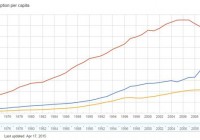How Greece Is Impacting The Financial Markets
From my perspective, the greater risk to investors is not their relative exposure to the country of Greece in their portfolios, but their relative exposure to other countries. I contend that international stocks, particularly within Europe and also including certain emerging markets, are an attractive asset class for risk-adjusted return potential over the intermediate- to long-term. Any pullbacks in international equity strategies (and European-based strategies in particular) as a result of the ongoing Greek drama, may present an attractive entry point, or re-entry point, for some investors. A lot of the volatility witnessed across global stock markets thus far in 2015 can be attributed to the ongoing soap opera involving Greece, the European Union and the International Monetary Fund. Greece, arguably the most notorious of the P.I.I.G.S. (Portugal, Italy, Ireland, Greece and Spain) countries, has been confronting a mountain of debt issues – currently estimated at 320 billion Euros – within the country for years. If that number is not staggering enough, consider these other economic statistics plaguing the country of Greece: Gross Domestic Product has fallen by 25% since 2010 A Debt-to-GDP ratio of 177% An unemployment Rate of 27% More than 20% of the Greek population is over the age of 65 – making it the world’s 5th oldest nation – and only 14% of the population is under the age of 15 (Data sources: BBC News, ECB, IMF, Green National Statistics Agency, Bloomberg.) With Greece in need of another bailout, or debt restructuring, to avoid defaulting on a significant repayment to the IMF at the end of June (and more to come thereafter), and Greece Prime Minister Tsipras opposing additional austerity measures (ex. pension cuts and potential increases to the age of retirement for these purposes in Greece) that may be a part of any new debt deal, many market participants are now bracing for the increased likelihood that Greece will leave the Euro – whether on their own or at the request of the EU. Germany, as the largest member of the EU, which Greece reportedly owes $56 billion alone, is showing signs of diminished interest in saving Greece again. This dubious view is shared elsewhere in Europe which suggests that this standoff may remain until the end of June deadline. While it is unknown if either party will blink first, or if the proverbial can will be kicked further down the road, we, at Hennion & Walsh, believe that it is appropriate for investors to consider the impact that a Greece exit from the Euro (now being referred to by many as the Grexit) would have on their portfolios and financial markets overall. Using a couple of the larger and more popular international equity exchange-traded funds below, including one Europe-specific strategy, as proxies, it would appear as though investors may not actually have that much exposure to Greece if they are investing in international equities through these types of product structures. FTSE Europe ETF (NYSEARCA: VGK ) has a 0.07% allocation to Greece as of May 31, 2015, according to Morningstar. iShares MSCI EAFE ETF (NYSEARCA: EFA ) has a 0.00% allocation to Greece as of May 31, 2015, according to Morningstar. From my perspective, the greater risk to investors is not their relative exposure to the country of Greece in their portfolios but rather their relative exposure to other countries that may be impacted by either a Greek default or a further extension of credit to this debt-burdened country. To this end, any funds “saved” by not allowing for any future Greece bailouts could be applied to additional quantitative easing measures or other economic stimulus programs within the Eurozone. It is worth noting that the fear of contagion throughout the Eurozone also adds to the volatility in the region each time a potential Grexit is in the headlines. I contend that international stocks, particularly within Europe and also including certain emerging markets, are an attractive asset class for risk-adjusted return potential over the intermediate-longer term. I would even suggest that having Greece ultimately leave the Euro would provide some certainty to international investors and relieve Europe of one of the anchors holding down their own economic recovery. Thus, any pullbacks in international equity strategies, European-based strategies in particular, as a result of the ongoing Greek drama may present an attractive entry point, or re-entry point, for some investors. Disclosure: Hennion & Walsh Asset Management currently has allocations within its managed money program consistent with the investment theme discussed in this article. This post is for educational purposes only and should not be considered as a solicitation to purchase or sell any of the securities or investment themes mentioned. International investments have their own unique set of risks that should be understood before considering an investment. As a reminder, all investment decisions in our view should be made consistent with an investor’s financial goals, tolerance for risk and investment timeframe. Disclosure: I/we have no positions in any stocks mentioned, and no plans to initiate any positions within the next 72 hours. (More…) I wrote this article myself, and it expresses my own opinions. I am not receiving compensation for it. I have no business relationship with any company whose stock is mentioned in this article.
